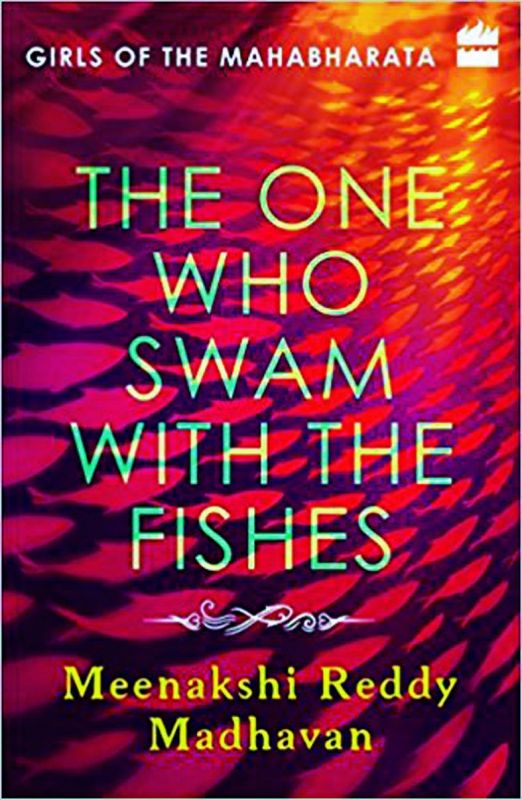Epic women's tale
Author Meenakshi Reddy Madhavan explores the stories of queens, wives and mothers of Mahabharata.

The story of the epic Mahabharata and its characters has been re-told and re-written innumerable times. However, in most of these stories, the male characters of the story take centre stage, while the female characters are often sidelined. Meenakshi Reddy Madhavan is here to change that, as she narrates the story of the women of the Mahabharata in a new series.
In the first book of the series, The One Who Swam with the Fishes: Girls of the Mahabharata, Meenakshi explores the story of the Kuru queen, Satyavati, the great-grandmother of the Pandava and Kaurava princes.
 The One Who Swam with the Fishes: Girls of the Mahabharata by by Meenakshi Reddy Madhavan Rs 250, pp 160 Harper Collins.
The One Who Swam with the Fishes: Girls of the Mahabharata by by Meenakshi Reddy Madhavan Rs 250, pp 160 Harper Collins.
Although many of us know that a fisherman raised her despite she being of royal descent and that her eldest son — the seer Vyasa — went on to write the Mahabharata, there is very little known about her as a character.
Ask Meenakshi what prompted her to write these stories and she says, “Several different thoughts led to my decision of proposing the book series. While discussing the Mahabharata or the Ramayana, I was always struck by how little we understood about the women’s motivations and feelings. We knew they were there and that they existed, and sometimes we know what they said, but not so much about what led them there. And the minor characters never got more than a fleeting mention.”
The author plans to write 12 books, featuring all the women referred to in the epic, including the Kashi princess Amba, who vowed to kill Bheeshma, and Gandhari and Kunti.
But why start with Satyavati, when Draupadi and Kunti are the more famous characters, we asked. “I picked her because she was the first ‘girl of the Mahabharata’ and I wanted to do the series in a chronological order. So, when you read them sequentially, you see favourite characters returning, and the world they lived in fits like a jigsaw puzzle,” she says in a matter of fact tone.
“There’s so much to love about Satyavati as a character. She’s very mysterious, no matter which version of her you believe in — the sexual kitten a la Lolita or the shy, reluctant maiden, with an incredible back story about a king, a falcon and an apsara-turned-fish. I was amazed there wasn’t much written about her. I chose to turn my Satyavati into a foundling, reserved by nature but with a rich and vivid imagination. Along her way to queendom, unspeakable things happen to her and she emerges out of them victorious through the trial by fire, older and wiser but also losing a part of herself forever,” she says.
Even as a kid, Meenakshi loved reading various folklore and epics. “I remember I had a lot of books. One of them was Ramanujan’s collection of Indian folk tales, which I was obsessed with, some Children’s Book Trust books like Folk Tales of
The Punjab and loads of Amar Chitra Katha. I had quite a collection all bought from the pavements of the second-hand books’ market in Delhi. My parents bound them for me in sets of 20, so I could go back to them again and again,” she reminisces fondly.
Not only is the Mahabharata very popular but it is also very lengthy and complicated. Ask the author about the kind of research she did before writing the book, and she quips, “I did return to the versions of the myth, plus dipped into critical essays about the Mahabharata, Yuganta being a prime example, and made some notes before I began. Mostly, I was concerned about simple things like what they ate, what they wore, and how they would address each other. It took me several drafts until I finally ironed out all the anachronisms.”
Meenakshi feels that women, even then, were not independent and had to be submissive to be accepted. However, the problem arises when people expect women today to take inspiration from these characters. “There’s a bit in the Mahabharata, where Draupadi is talking about how she’s a good wife and among other things, she says, she never bathes or sleeps until her husband — whichever one it was — has bathed or slept. She always served them water and offered them a seat whenever they returned to her and never spoke to them in a ‘fretful voice’. In other words, she never complained. Sita, too, is held up as the perfect Hindu woman, devoted to her husband even after she was abducted. The problem is that these epics date back thousands of years ago, some say as far back as 200 BC. And while life has changed, people’s attitudes towards women have mostly stayed the same. In a world where a cow is given a more respectable status than a woman, I think we need to look back at history and learn to change what we can. Women want independence and men don’t want to give it to them. When women demand the rights that are due, men often react with violence. In the year 200 BC, women would have acquiesced to this, but in 2017 AD, it’s about time things changed,” reasons Meenakshi, who loves to travel and explore places whenever she gets some time.
Lastly, talking about her writing schedule, she says, “It’s pretty erratic; some weeks of frantic activity, clocking in a few thousand words a day while other days lying on my back gazing at the ceiling wondering if I made the right decision a few chapters ago. I envy writers who have a real work ethic and stick to it. Mine is full of ups and downs and whims and fancies.”

